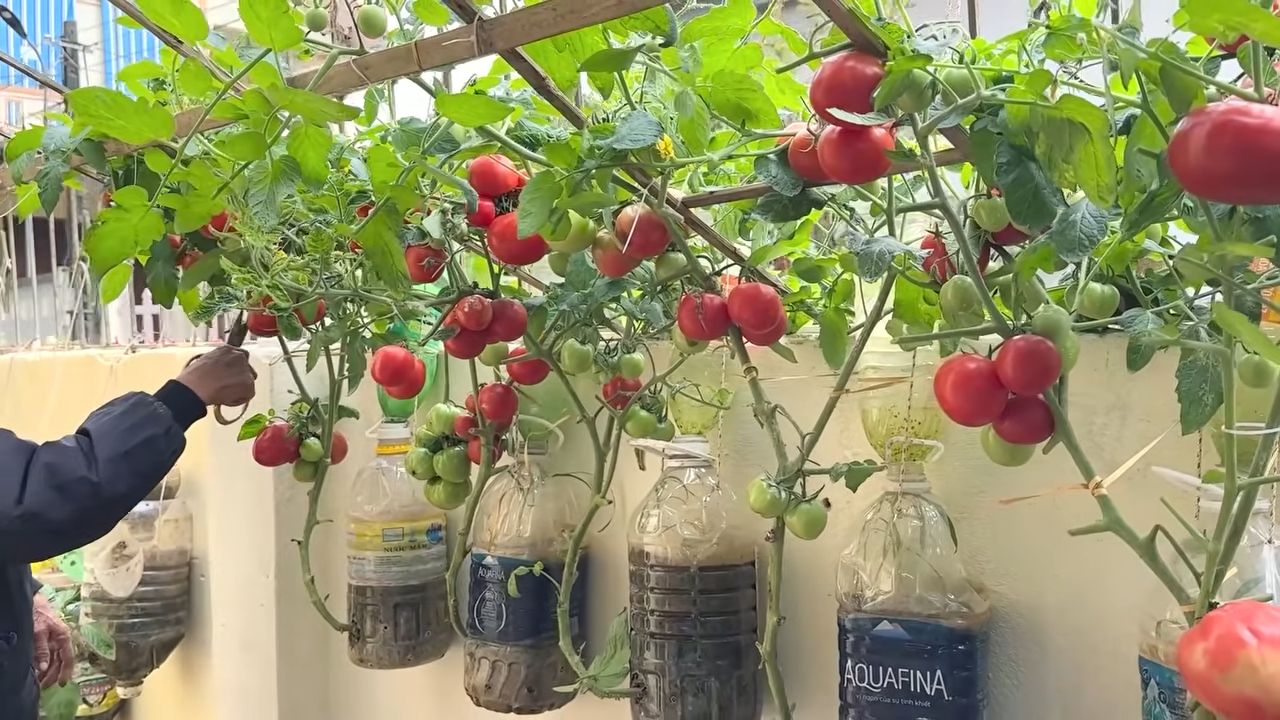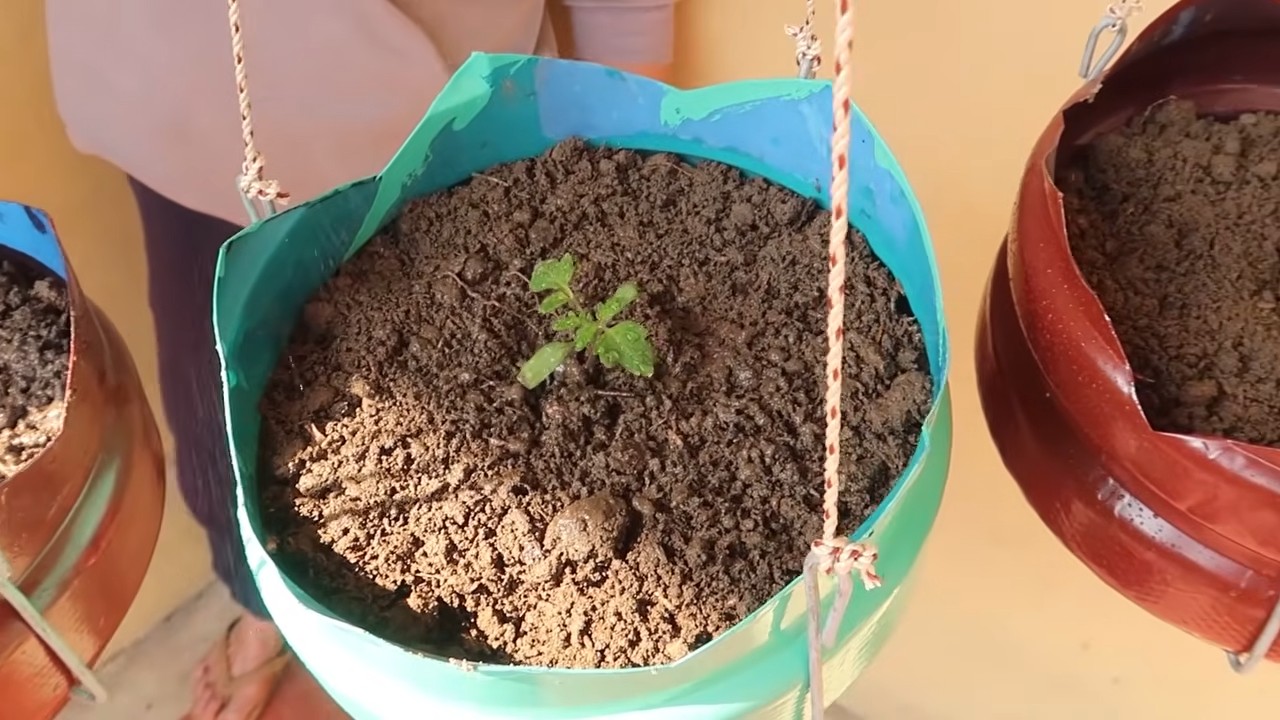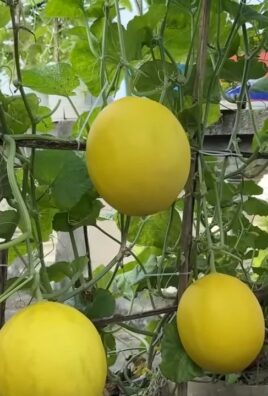Tomato care tips are essential for anyone dreaming of vine-ripened, juicy tomatoes bursting with flavor straight from their own backyard! Let’s be honest, there’s nothing quite like the taste of a homegrown tomato, is there? Forget those bland, store-bought imitations – we’re talking about the real deal, the kind that makes your summer salads sing and your sandwiches unforgettable.
For centuries, tomatoes have held a special place in cultures around the world. Originating in South America, they were initially viewed with suspicion in Europe, but eventually, their vibrant color and delicious taste won everyone over. Now, they’re a staple in cuisines globally, from Italian pasta sauces to Mexican salsas.
But growing these beauties can sometimes feel like a challenge, right? That’s where these tomato care tips come in! I’m going to share some simple, yet effective DIY tricks and hacks that will help you nurture your tomato plants from tiny seedlings to bountiful producers. Whether you’re a seasoned gardener or just starting out, these tips will empower you to overcome common problems like blossom end rot, pests, and diseases. Imagine the satisfaction of harvesting your own delicious tomatoes, knowing you nurtured them every step of the way. Let’s get started and unlock the secrets to a thriving tomato garden!

DIY Tomato Cage Upgrade: From Wobbly to Wonderful!
Hey there, fellow tomato enthusiasts! Are you tired of those flimsy tomato cages that buckle under the weight of your bountiful harvest? I know I was! This year, I decided to ditch the store-bought cages and create my own super-sturdy, customizable tomato support system. And guess what? It’s easier than you think! This guide will walk you through building your own robust tomato cages that will keep your plants happy and your tomatoes off the ground.
Materials You’ll Need
Before we dive in, let’s gather our supplies. This is what I used, but feel free to adapt based on what you have available or prefer:
* Concrete Reinforcement Mesh (Remesh): This is the star of the show! You can usually find it at your local home improvement store. I recommend getting a sheet that’s at least 5 feet wide and 7 feet long. This will give you enough material to make several cages.
* Bolt Cutters: Essential for cutting the remesh. Trust me, you won’t want to try using anything else.
* Gloves: Protect your hands from the sharp edges of the remesh.
* Safety Glasses: Safety first! Always wear eye protection when working with metal.
* Measuring Tape: For accurate cuts and cage sizing.
* Zip Ties (Heavy Duty): To secure the cage together. I prefer the heavy-duty ones for extra strength.
* Optional: Metal Stakes or Rebar: For extra support, especially in windy areas.
* Optional: Bright Colored Spray Paint: To make the cages more visible and prevent accidental tripping.
Planning Your Cage Size
Okay, before we start cutting, let’s think about the size of your cages. This will depend on the type of tomatoes you’re growing.
* Determinate Tomatoes: These are bush-type tomatoes that grow to a certain size and then stop. For these, a cage that’s about 18-24 inches in diameter and 4-5 feet tall should be sufficient.
* Indeterminate Tomatoes: These are vining tomatoes that will keep growing until frost. They need much larger cages! I recommend a diameter of at least 24-36 inches and a height of 5-6 feet.
I’m growing mostly indeterminate varieties this year, so I’m going for the larger size.
Cutting and Shaping the Remesh
This is where the fun (and a little bit of muscle) comes in!
1. Measure and Mark: Using your measuring tape and a permanent marker, measure and mark the remesh according to the desired height of your cage. Remember to add a few extra inches to overlap the edges for securing the cage. For example, if you want a 5-foot tall cage, mark it at 5 feet 3 inches.
2. Cut the Remesh: Put on your gloves and safety glasses! Using the bolt cutters, carefully cut along the marked line. It’s best to cut one wire at a time. Be patient and take your time. The cut edges will be sharp, so handle them with care.
3. Shape the Cage: Now, carefully bend the cut piece of remesh into a cylinder shape. This might take a little bit of effort, but the remesh is surprisingly flexible.
4. Overlap the Edges: Overlap the edges of the remesh by a few inches. This is where you’ll secure the cage together.
Securing the Cage
Now that we have our cylinder, it’s time to make it a permanent cage!
1. Attach Zip Ties: Using heavy-duty zip ties, secure the overlapping edges of the remesh together. Start at the top and bottom, and then add zip ties every 6-8 inches along the seam.
2. Tighten and Trim: Make sure the zip ties are nice and tight. Use pliers if needed to get a good grip. Once they’re secure, trim off the excess zip tie ends with wire cutters or scissors. This will prevent them from snagging on anything.
3. Inspect for Sharp Edges: Run your hand along the cage, feeling for any sharp edges. If you find any, you can either bend them over with pliers or cover them with duct tape.
Adding Extra Support (Optional)
If you live in a windy area or are growing particularly heavy tomato varieties, you might want to add some extra support to your cages.
1. Drive Stakes into the Ground: Use metal stakes or rebar to provide additional support. Drive the stakes into the ground near the base of the cage.
2. Attach Cage to Stakes: Use zip ties or wire to attach the cage to the stakes. This will help prevent the cage from tipping over in strong winds.
Painting the Cages (Optional)
Painting your cages is purely for aesthetic purposes, but it can also make them more visible in the garden.
1. Choose Your Paint: Select a bright-colored spray paint that’s suitable for metal.
2. Prepare the Cages: Make sure the cages are clean and dry before painting.
3. Spray Paint: Apply several light coats of spray paint, allowing each coat to dry completely before applying the next.
Planting Your Tomatoes
Now that your cages are ready, it’s time to plant your tomatoes!
1. Prepare the Soil: Dig a hole that’s large enough to accommodate the root ball of your tomato plant. Amend the soil with compost or other organic matter.
2. Place the Cage: Carefully place the tomato cage over the planting hole.
3. Plant the Tomato: Gently remove the tomato plant from its container and place it in the hole.
4. Backfill with Soil: Backfill the hole with soil, making sure to cover the root ball completely.
5. Water Thoroughly: Water the tomato plant thoroughly after planting.
Ongoing Care
Your tomato plants will need regular care throughout the growing season.
* Watering: Water your tomato plants deeply and regularly, especially during hot, dry weather.
* Fertilizing: Fertilize your tomato plants every few weeks with a balanced fertilizer.
* Pruning: Prune your tomato plants regularly to remove suckers and improve air circulation.
* Pest Control: Keep an eye out for pests and diseases, and take action promptly if you see any problems.
Tips and Tricks
Here are a few extra tips and tricks that I’ve learned over the years:
* Use Mulch: Apply a layer of mulch around your tomato plants to help retain moisture and suppress weeds.
* Rotate Your Crops: Rotate your tomato crops each year to prevent soilborne diseases.
* Harvest Regularly: Harvest your tomatoes regularly to encourage more production.
* Consider Companion Planting: Plant basil near your tomatoes. Basil is said to improve the flavor of tomatoes and deter pests.
* Don’t Overwater: Overwatering can lead to root rot and other problems. Make sure the soil is well-draining.
* Support Heavy Branches: As your tomatoes grow, the branches may become heavy with fruit. Use twine or cloth strips to support any branches that are in danger of breaking.
* Observe Your Plants: Pay attention to your tomato plants and learn to recognize the signs of stress or disease. The sooner you catch a problem, the easier it will be to fix.
* Recycle and Reuse: At the end of the season, clean and store your tomato cages for use next year. They should last for many years with proper care.
Troubleshooting
Even with the best planning, things can sometimes go wrong. Here are a few common problems and how to fix them:
* Cage Tipping Over: If your cage is tipping over, add more stakes or use larger stakes. You can also try burying the bottom of the cage a few inches into the ground.
* Tomatoes Rotting on the Ground: If your tomatoes are rotting on the ground, it could be due to poor air circulation or contact with the soil. Make sure your plants are properly pruned and that the cages are providing adequate support.
* Pests and Diseases: If you’re having problems with pests or diseases, consult your local garden center or extension office for advice. There are many organic and chemical control options available.
Building your own tomato cages is a rewarding project that will save you money and provide your tomato plants with the support they need to thrive. So, grab your tools, get your hands dirty, and get ready for a bumper crop of delicious tomatoes! Happy gardening!

Conclusion
So, there you have it! Mastering these simple yet effective DIY tomato care tips can truly transform your tomato-growing experience. We’ve explored how to create nutrient-rich soil amendments, craft protective barriers against pests, and even brew your own natural fertilizers – all designed to help you cultivate the juiciest, most flavorful tomatoes imaginable.
Why is this a must-try? Because it’s about more than just growing tomatoes; it’s about connecting with nature, understanding the needs of your plants, and reaping the rewards of your own hard work. Store-bought solutions can be expensive and often contain harsh chemicals. These DIY methods are not only cost-effective and environmentally friendly, but they also empower you to take control of your garden’s health and vitality. You’ll know exactly what’s going into your plants, ensuring a harvest that’s both delicious and safe for your family.
Consider these variations to further personalize your tomato care routine:
* **Compost Tea Boost:** Experiment with different ingredients in your compost tea. Adding banana peels provides extra potassium, while coffee grounds contribute nitrogen and acidity that tomatoes love.
* Eggshell Calcium Infusion: Instead of just crushing eggshells, try baking them at a low temperature to make them even more brittle and easier for the plants to absorb. You can also soak crushed eggshells in vinegar to create a calcium-rich solution for watering.
* Companion Planting Power: Enhance your pest control by strategically planting companion plants like basil, marigolds, or nasturtiums around your tomato plants. These plants naturally repel pests and attract beneficial insects.
* Vertical Gardening Advantage: If space is limited, explore vertical gardening techniques using trellises, cages, or hanging baskets. This not only saves space but also improves air circulation around the plants, reducing the risk of fungal diseases.
* Sunlight Optimization: Pay close attention to the amount of sunlight your tomato plants receive. If you live in a particularly hot climate, consider providing some afternoon shade to prevent sunscald.
We firmly believe that these DIY tomato care tips will make a significant difference in the health and productivity of your tomato plants. But don’t just take our word for it – try them out for yourself! We’re confident that you’ll be amazed by the results.
We encourage you to embark on this tomato-growing adventure and share your experiences with us. Did you try a particular variation? Did you discover any new tips or tricks along the way? We’d love to hear your stories and learn from your successes (and even your challenges!). Share your photos, recipes, and gardening wisdom in the comments section below. Let’s create a community of passionate tomato growers who are dedicated to cultivating the best possible harvest, one DIY trick at a time. Happy gardening!
Frequently Asked Questions (FAQ)
What are the most common problems I might encounter when growing tomatoes, and how can these DIY tips help?
Many common tomato problems, such as blossom end rot (caused by calcium deficiency), pest infestations (like aphids and tomato hornworms), and fungal diseases (like early blight and septoria leaf spot), can be effectively addressed with these DIY methods. The eggshell calcium infusion helps prevent blossom end rot, the garlic spray deters pests, and ensuring good soil drainage and air circulation (through proper spacing and pruning) minimizes fungal issues. Furthermore, a healthy, well-nourished plant is inherently more resistant to disease and pests.
How often should I apply the DIY fertilizers and pest control solutions?
The frequency depends on the specific solution and the needs of your plants. For compost tea, a weekly application during the growing season is generally beneficial. The eggshell calcium infusion can be applied every two to three weeks, especially during fruit development. Garlic spray should be applied as needed, typically after rain or when you notice signs of pest activity. Always observe your plants closely and adjust the frequency based on their response. If you see signs of over-fertilization (such as leaf burn), reduce the frequency.
Are these DIY tomato care tips suitable for all types of tomatoes?
Yes, these tips are generally applicable to all types of tomatoes, including determinate (bush) varieties and indeterminate (vining) varieties. However, you may need to adjust the application based on the specific needs of each variety. For example, larger indeterminate varieties may require more frequent fertilization and pest control due to their higher growth rate and susceptibility to pests.
Can I use these DIY methods in conjunction with store-bought fertilizers or pesticides?
While these DIY methods are designed to be a natural and sustainable alternative to store-bought products, you can use them in conjunction with commercial products if necessary. However, it’s important to be cautious and avoid over-fertilization or the use of harsh chemicals that could harm your plants or the environment. Start with the DIY methods and only supplement with commercial products if you’re not seeing the desired results. Always follow the instructions on the label of any commercial product and be mindful of potential interactions with the DIY solutions.
What if I don’t have access to all the ingredients for these DIY recipes?
Don’t worry! Many of these recipes can be adapted based on what you have available. For example, if you don’t have banana peels for compost tea, you can use other potassium-rich ingredients like wood ash or seaweed. If you don’t have garlic for the pest control spray, you can use other pungent herbs like onions or chives. The key is to experiment and find what works best for you and your plants. The goal is to provide your plants with the nutrients and protection they need using readily available and sustainable resources.
How do I know if my tomato plants are getting too much or not enough of a particular nutrient?
Observing your plants closely is crucial. Yellowing leaves can indicate a nitrogen deficiency, while purplish leaves can suggest a phosphorus deficiency. Blossom end rot is a classic sign of calcium deficiency. Over-fertilization can lead to leaf burn (brown, crispy edges) or excessive vegetative growth at the expense of fruit production. Research common tomato nutrient deficiencies and toxicities, and compare the symptoms to what you’re seeing in your plants. Soil testing can also provide valuable information about the nutrient levels in your soil.
What are some other natural ways to improve my tomato plants’ health?
In addition to the DIY tips mentioned in the article, consider these other natural methods:
* Mulching: Apply a layer of organic mulch (such as straw, wood chips, or shredded leaves) around your tomato plants to retain moisture, suppress weeds, and regulate soil temperature.
* Watering deeply and infrequently: Water your tomato plants deeply and less often, rather than shallowly and frequently. This encourages deep root growth, making the plants more drought-tolerant and resilient.
* Pruning: Prune your tomato plants regularly to remove suckers (the small shoots that grow between the main stem and the branches). This improves air circulation, reduces the risk of fungal diseases, and encourages fruit production.
* Rotating crops: Avoid planting tomatoes in the same spot year after year. Crop rotation helps prevent the buildup of soilborne diseases and pests.
* Attracting pollinators: Plant flowers that attract pollinators (such as bees and butterflies) near your tomato plants to ensure good pollination and fruit set.
How can I ensure my DIY tomato care efforts are truly organic?
To ensure your DIY tomato care is truly organic, use only organic ingredients and avoid any synthetic fertilizers or pesticides. Choose organic seeds or seedlings, and amend your soil with organic compost and other natural materials. Be mindful of the source of your ingredients and ensure they are certified organic if possible. Regularly inspect your plants for pests and diseases and address any issues promptly using organic methods. By following these guidelines, you can create a healthy and thriving organic tomato garden.




Leave a Comment